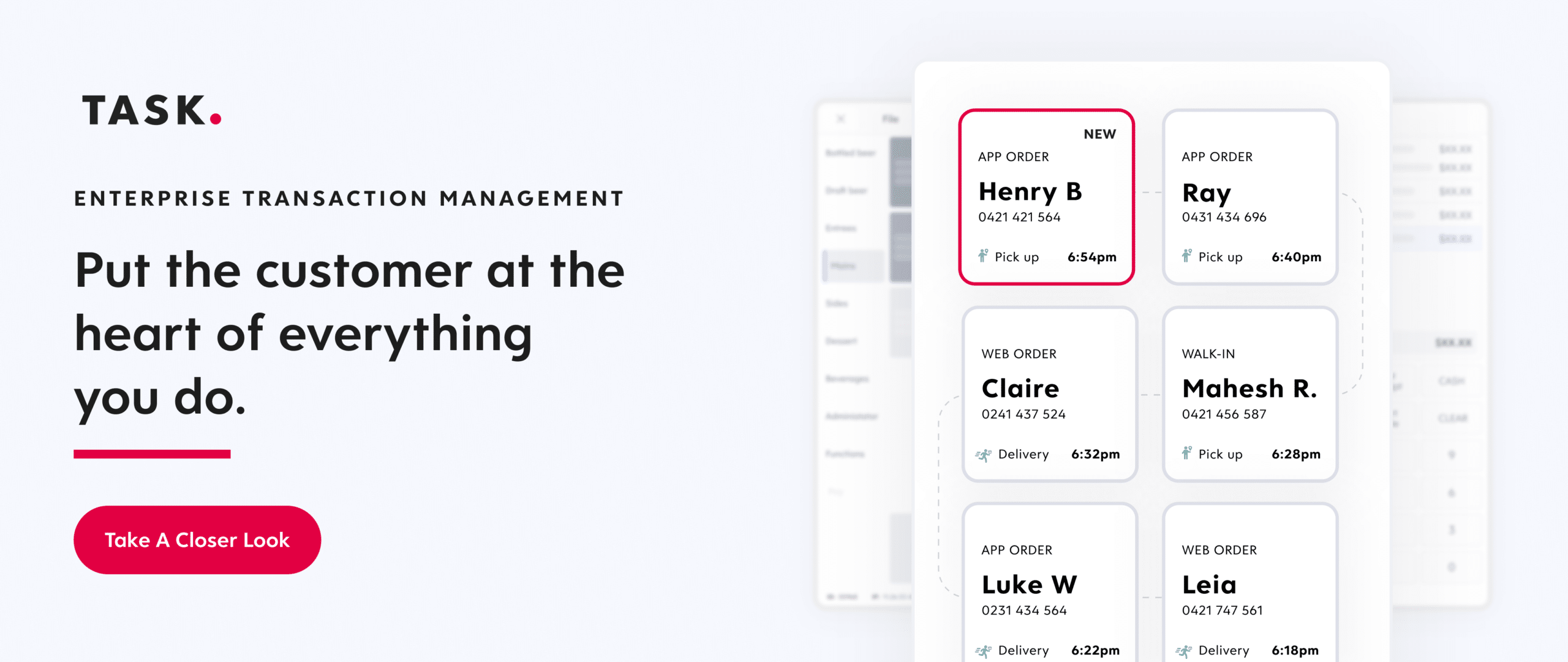When it comes to driving growth for your brand and increasing overall sales, it’s all about how you design and deliver better experiences for your customers. Many leading hospitality brands understand how to do this in traditional brick-and-mortar settings – but there are many more questions out there about how to capture the same great experiences across digital touchpoints.
Digital ordering is quickly becoming the preferred channel for customers, and that’s great news for hospitality businesses: digital orders are larger, they lead to higher revenue, and they carve out more opportunities for brands to develop lasting relationships with loyal customers.
However, taking advantage of all that digital experiences can offer requires more than just a robust technology framework. It takes strategic, customer-centric design and a thorough understanding of the digital path to purchase. Here’s an overview of what that process looks like, with key insights from TASK Group’s Plexure Division Customer Success Manager, Kerri Linderboom, and TASK’s US President John Laporte
Why Is Digital Ordering a Massive Opportunity for Restaurants?
For customers, digital ordering offers better convenience, faster service without waiting in line, and the power to engage with a brand from anywhere. Digital channels by nature can reach more devices across greater distances, giving your brand the chance to increase your customer footprint without having to physically expand or relocate.
The other side of digital ordering is the chance to capture your customers more effectively, building stronger relationships with them in less time through personalization, timely promotional offers, and strategic upsells and deals. By leveraging advanced machine learning and real-time data, digital ordering platforms can carve a long-term path toward loyalty and retention.
As Kerri explains, “The end goal is to develop higher rates of retention and a stronger brand reputation, as that is where you see the highest customer values. Customer journey mapping shows us that it costs five (and in some cases, seven) times as much to acquire a customer than it does to retain one. Focusing on driving better experiences that will lead to retention is, therefore, the best way to drive higher sales in the long-term.”
Kitchen Innovations Revolutionizing Back-Of-House Operations
Struggling to keep up with staff shortages and rising costs? It might be time to leverage technology to streamline your back-of-house operations.
What Should Restaurants Do to Win Digital Ordering?
Competition and a significant pull toward digital channels mean that customer expectations are at an all-time high when it comes to ordering platforms. As Kerri says, “Customers expect smooth, easy convenience every step of the way. We’ve become a generation of digital consumers who have no time for a slow or confusing digital interface. If we don’t like an app, we delete it. If we don’t feel connected to a brand, we forget it.”
The key to grabbing hold of customers and ensuring they stick around to see through their purchase (and come back for more) is to ensure you take advantage of every opportunity to deliver memorable experiences.
John explains, “Everything comes down to delivering a better customer experience. A successful digital transformation is all about developing a close connection with your customer, listening to their needs, and responding to their preferences.”
To identify exactly where the decision-making points are located, brands should start by mapping their customer journey.
Pinpointing the Key Moments Of Your Customer Journey
The first question that brands must ask themselves is – how are customers navigating the path to purchase across digital channels?
Kerri explains, “Think about going through a clothing store, where there is a literal path to purchase. You can predict some issues, such as bad lighting in the dressing room, not having enough stock in the right sizes, or the racks getting messy due to not having enough staff on hand. The key to a great customer journey isn’t just about avoiding those issues, because that isn’t always possible. It’s also about preparing for issues, and having a clear system in place for communicating with your customer when things go wrong.”
For example, if your app is experiencing problems, it’s far better to explain that the system is experiencing a delay than to allow customers to get frustrated halfway through their order. This is what Kerri terms “Moments of Truth” – the revealing moments after any kind of issue where brands will either demonstrate their value or lose a customer entirely.
John adds, “You need to be in a position where you can quickly recuperate any missteps. You do this by constantly testing your service, making small changes, and reflecting on any feedback you receive from your customers.”
The challenge of optimizing your digital path to purchase starts by breaking down these moments of truth is a helpful way to map out your entire digital customer journey and look for opportunities to either avoid potential friction points or add pieces of unexpected delight to the experience. Considering the emotional journey that your customers may experience across your digital channels is also important. If a promotion is applied at checkout, for example, customers might feel a strong sense of excitement, but adding the promotion at that moment may not encourage them to add to their order. Looking strategically at where along the journey add-on suggestions, promotional offers, and messaging are placed is essential to creating a smooth experience that also drives higher sales.
Optimizing Your Menu for Maximizing Profit
Menu optimization is helping businesses increase order sizes, boost profits, and maximize the customer experience.
Employ a Technology Tool That Can Help Make the Most of Customer Data
“The first thing to understand,” says Kerri, “is that your product and your service have to meet your customers’ needs. Remember that needs and preferences change over time, and they change even faster in the digital space.”
The power of real-time data is that it shows the fluctuations in these customer needs at all times. It is possible to uncover trends quickly, but it’s also important to realize that these trends are always susceptible to change.
Kerri says, “Simply put, brands must remember that they are dealing with humans, who all have emotional needs and changing circumstances and schedules. Maybe you have a customer who usually meal-preps during the week, but has just had a busy few days and is left hungry at the end of a workday. Maybe they have family in town and need a much larger order than usual. The key to unlocking all opportunities for sales is to stay flexible and respond to behavioral changes.”
Transaction management platforms help restaurants track key data points across the customer journey, making it possible to assess the real-time needs of customers. A fully integrated system can offer:
- Holistic insight into customers and their actions
- A deeper understanding of how and when their customers make decisions
- Insight into where along the digital journey customers have abandoned their purchases
- Analytics around how customer journey success corresponds to sales data
- A centralized, single source of truth about customer decision-making
Leveraging historical data in combination with real-time insights can further help brands facilitate better online ordering experiences, whether that is through improving the digital layout and flow or identifying better menu customization.
How to Choose the Right Technology Partners Across the Digital Foodservice Ecosystem
“You’re only as good as your end-to-end software,” says Kerri. “You can have a healthy funnel that gets customers through the door, but if you can’t support their entire journey and their movements through to the end, then you’re just relocating your problems, not solving them.”
The key to a successful digital customer journey is understanding the needs and wants of your customer first, and then emphasizing the pieces that matter most. For example, if you know your customers care a great deal about convenience and speed of service, then that is where you put your emphasis. If your brand is about delivering top quality, relaxed experiences, however, then your focus will of course be quite different.
The best technology partners are the ones to look first and foremost at customer experience. It is only once you know your customers, their decision-making process, and where their friction points might be that you can design a digital journey that will not just function flawlessly, but function the best for your particular brand needs.
From there, everything comes down to the capabilities and integration of your digital system. Brands should seek out technology systems that can be adapted to suit changing customer and operational needs, that can provide a robust system for data integration and analytics, and that can work seamlessly across digital platforms and tools.
Ultimately, a single-solution technology system gives brands the ability to map their digital customer journey and identify strategic moments along the path to purchase.

